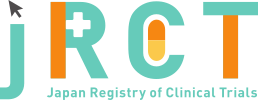臨床研究等提出・公開システム
|
Mar. 30, 2020 |
|
|
May. 30, 2022 |
|
|
jRCTc050190126 |
Clinical study of autologous noncultured epidermal cell transplantation for leucodelma treatment |
|
Clinical study of autologous noncultured epidermal cell transplantation for leucodelma treatment |
|
|
Takehara Tetsuo |
Mar. 25, 2022 |
|
5 |
|
5 cases conducted cell transplantation consisted of one segmental vitiligo and four generalized vitiligo. 1) 27-year-old male segmental 2) 25-year-old female generalized 3) 76-year-old male generalized 4) 74-year-old male generalized 5) 75-year-old female generalized |
|
The target 5 cases were resistered, and autologous noncultured epidermal cell transplantation was conducted to all cases. The safety and efficacy were evaluated by regular observation 3 months and 6 months after the operation. |
|
No adverse events caused by this cell transplantation. |
|
Primary endpoints: repigmentation rate Repigmentation rate on the epidermal cell transplantation sites H-01: 2.49% and 2.88% of repigmentation rate 3 and 6 months after treatment, respectively H-02: 31.99% and 32.12% of repigmentation rate 3 and 6 months after treatment, respectively H-03: 34.19% and 30.89% of repigmentation rate 3 and 6 months after treatment, respectively H-04: Undeterminable because of not differentiating from repigmentation to skin redness 3 and 6 months after treatment H-05: Undeterminable because of not differentiating from repigmentation to skin redness 3 and 6 months after treatment Repigmentation rate on the suction blister epidermal transplantation sites H-01: 3.28% and 10.52% of repigmentation rate 3 and 6 months after treatment, respectively H-02: 20.27% and 20.96% of repigmentation rate 3 and 6 months after treatment, respectively H-03: 88.03% and 81.82% of repigmentation rate 3 and 6 months after treatment, respectively H-04: 41.21% and 50.21% of repigmentation rate 3 and 6 months after treatment, respectively H-05: Undeterminable because of not differentiating from repigmentation to skin redness 3 and 6 months after treatment Secondary endpoints Melanin index (pretreatment/3 months after treatment/6 months after treatment) Case: H-01 Epidermal cell transplantation (mean): 101.5/86.8/134.3 Suction blister epidermal transplantation (mean): 102.0/78.0/112.7 Control(mean): 95.8, 65.3, 103.3 Case: H-02 Epidermal cell transplantation (mean): 61.5/82.3/93.7 Suction blister epidermal transplantation (mean): 62.7/74.3/91.0 Control(mean): 100.7, 78.5, 121.5 Case: H-03 Epidermal cell transplantation (mean): 96.3/178.3/172.5 Suction blister epidermal transplantation (mean): 102.5/194.5/216.5 Control(mean): 81.5, 89.5, 83.2 Case: H-04 Epidermal cell transplantation (mean): 24.7/35.0/29.5 Suction blister epidermal transplantation (mean): 10.5/65.3/100.8 Control(mean): 6.0, 23.2, 24.3 Case: H-05 Epidermal cell transplantation (mean): 64.3/32.3/46.3 Suction blister epidermal transplantation (mean): 68.7/29.8/46.2 Control(mean): 64.3, 49.0, 50.2 Hemoglobin index (pretreatment/3 months after treatment/6 months after treatment) Case: H-01 Epidermal cell transplantation (mean): 354.7/496.5/370.0 Suction blister epidermal transplantation (mean): 393.2/464.8/384.3 Control(mean): 525.3, 505.3, 507.8 Case: H-02 Epidermal cell transplantation (mean): 87.0/208.0/168.5 Suction blister epidermal transplantation (mean): 94.3/134.5/170.7 Control(mean): 225.0, 108.5, 219.2 Case: H-03 Epidermal cell transplantation (mean): 179.2/286.2/345.2 Suction blister epidermal transplantation (mean): 228.8/279.7/407.2 Control(mean): 179.0, 133.8, 198.5 Case: H-04 Epidermal cell transplantation (mean): 153.3/455.7/299.7 Suction blister epidermal transplantation (mean): 167.7/261.5/211.8 Control(mean): 176.5, 107.7, 135.7 Case: H-05 Epidermal cell transplantation (mean): 233.3/469.8/367.2 Suction blister epidermal transplantation (mean): 264.8/485.5/411.5 Control(mean): 245.5, 271.0, 180.2 Brief summary Since the number of 5 cases analyzed here was quite small, it is required to increase the sample size to evaluate the usefulness of epidermal cell transplantation properly. We did not encounter severe adverse event which indicated a safety of epidermal cell transplantation. While in case H-02 and -3, 25% or more of vitiliginous area reduction was found, other 3 cases might not have sufficient improvement of the treated lesions due to the remaining disease activity and loss of transplanted epidermal cells from the recipient sites. In order to provide the more efficient treatment, we suppose the importance to enroll the stable state patients and fix the translanted epidermal cells properly. |
|
(See the Outcome measures.) |
|
May. 31, 2022 |
|
https://jrct.mhlw.go.jp/latest-detail/jRCTc050190126 |
Tanemura Atsushi |
||
Osaka University Hospital |
||
2-2 Yamadaoka, Suita, Osaka Japan |
||
+81-6-6879-3031 |
||
tanemura@derma.med.osaka-u.ac.jp |
||
Yoshinaga Mio |
||
Osaka University Graduate School of Medicine |
||
2-2 Yamadaoka, Suita, Osaka Japan |
||
+81-6-6879-3031 |
||
166yoshinaga@derma.med.osaka-u.ac.jp |
| 5 | ||
Interventional |
||
single arm study |
||
open(masking not used) |
||
uncontrolled control |
||
single assignment |
||
treatment purpose |
||
Men and women aged over 20 years old with a diagonosis of stable vitiligo who visited the department of dermatology Osaka University Hospital and who signed a written informed consent by themselves after receiving the explanation of clinical study. |
||
Apparently unstable patients defined as new areas of depigmentation or enlarging areas of depigmentation within the last 12 months. |
||
| 20age old over | ||
| No limit | ||
Both |
||
stable vitiligo |
||
noncultured epidermal cell transplantation |
||
Evaluation of repigmentation rate of cell transplantation area (test site), suction blister transplantation area (comparison site), non-treated area (control site) by calculating the area of images taken by digital camera.Photographs are taken before, 3 months after and 6 months after the operation. Observation of the wound areas of donor site, test site, comparison site and control site as a safety evaluation. |
||
Evaluation of color matching (melanin and hemoglobin) on the test site, comparison site, control site and peripheral healthy site by the Mexameter. Incidence of adverse effects like infection, scarring and hemorrhoids resulting from the regenerative medicine as a safety evaluation. Color matching and safety evaluation are performed before, 3 months after and 6 months after the operation. |
||
| June. 03, 2019 | |
| Oct. 02, 2019 | |
Complete |
| Osaka City University, Department of Pigmentation Research and Therapeutics established by Kao Corporation | |
| Not applicable |
| The First Certified Special Committee for Regenerative Medicine, Osaka University | |
| 4F Center of Medical Innovation and Translational Research 2-2 Yamadaoka, Suita, Osaka, Osaka | |
+81-6-6210-8293 |
|
| nintei@dmi.med.osaka-u.ac.jp | |
| Approval | |
Mar. 07, 2019 |
| UMIN000037612 | |
| University hospital Medical Information Network |
